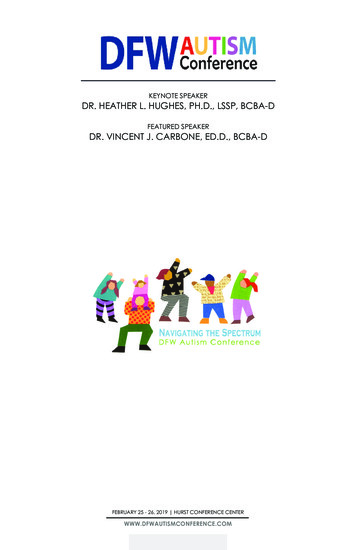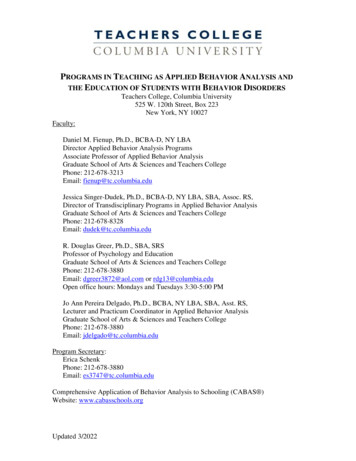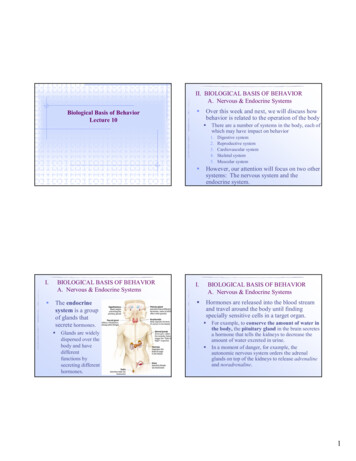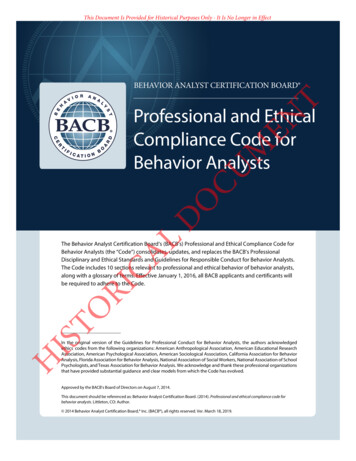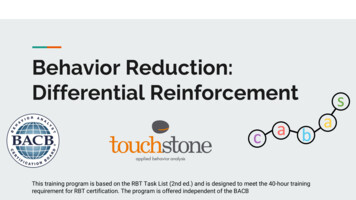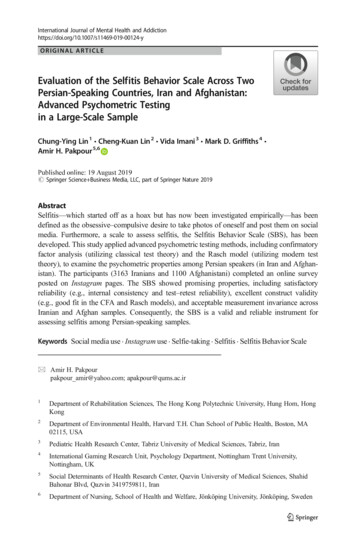
Transcription
International Journal of Mental Health and yORIGINAL ARTICLEEvaluation of the Selfitis Behavior Scale Across TwoPersian-Speaking Countries, Iran and Afghanistan:Advanced Psychometric Testingin a Large-Scale SampleChung-Ying Lin 1 & Cheng-Kuan Lin 2 & Vida Imani 3 & Mark D. Griffiths 4 &Amir H. Pakpour 5,6# Springer Science Business Media, LLC, part of Springer Nature 2019AbstractSelfitis—which started off as a hoax but has now been investigated empirically—has beendefined as the obsessive–compulsive desire to take photos of oneself and post them on socialmedia. Furthermore, a scale to assess selfitis, the Selfitis Behavior Scale (SBS), has beendeveloped. This study applied advanced psychometric testing methods, including confirmatoryfactor analysis (utilizing classical test theory) and the Rasch model (utilizing modern testtheory), to examine the psychometric properties among Persian speakers (in Iran and Afghanistan). The participants (3163 Iranians and 1100 Afghanistani) completed an online surveyposted on Instagram pages. The SBS showed promising properties, including satisfactoryreliability (e.g., internal consistency and test–retest reliability), excellent construct validity(e.g., good fit in the CFA and Rasch models), and acceptable measurement invariance acrossIranian and Afghan samples. Consequently, the SBS is a valid and reliable instrument forassessing selfitis among Persian-speaking samples.Keywords Social media use . Instagram use . Selfie-taking . Selfitis . Selfitis Behavior Scale* Amir H. Pakpourpakpour amir@yahoo.com; apakpour@qums.ac.ir1Department of Rehabilitation Sciences, The Hong Kong Polytechnic University, Hung Hom, HongKong2Department of Environmental Health, Harvard T.H. Chan School of Public Health, Boston, MA02115, USA3Pediatric Health Research Center, Tabriz University of Medical Sciences, Tabriz, Iran4International Gaming Research Unit, Psychology Department, Nottingham Trent University,Nottingham, UK5Social Determinants of Health Research Center, Qazvin University of Medical Sciences, ShahidBahonar Blvd, Qazvin 3419759811, Iran6Department of Nursing, School of Health and Welfare, Jönköping University, Jönköping, Sweden
International Journal of Mental Health and AddictionModern online activities, such as using social media and internet gaming, have become part ofdaily lives for most teenagers and young adults (Lin et al. 2017a). Acknowledging the negativepsychosocial effect of addiction to such internet-relevant activities among a small minority, thelatest (fifth) edition of the Diagnostic and Statistical Manual of Mental Disorders (i.e., DSM5) recognized Internet Gaming Disorder (IGD) as a tentative disorder (American PsychiatricAssociation 2013). Similar to IGD, other behaviors related to internet use, such as excessivesocial media use and habitual selfie-taking, have also become potential problems for a smallnumber of individuals’ psychological well being (Chen et al. 2019; Leung et al. 2019; Yamet al. 2019). Given the rise of well-known social media platforms (e.g., Facebook, Twitter,Instagram), there has been a growing interest of research investigating problematic socialmedia use and social media addiction in the contemporary literature on behavioral addiction(Alimoradi et al. 2019; Montag et al. 2015, 2017). However, unlike social media use, selfietaking is rarely discussed in the current literature although posting selfies is a very commonplace activity on social media platforms (e.g., uploading selfies to sites such as Facebook andInstagram).Selfitis appears to be another candidate within the scope of internet-related behaviors andhas been defined as “the obsessive compulsive desire to take photos of one’s self and post themon social media” (Griffiths and Balakrishnan 2018; p. 4). Like other online activities, selfietaking is a self-oriented action that allows users to establish their individuality and selfimportance (Balakrishnan and Griffiths 2018). In addition to merely taking photographs, theuploading of selfies among adolescents and young adults also involves editing of the color andchanging backgrounds, management of the social media platform, and interaction with otherusers on the same platform discussing the uploaded selfies (Balakrishnan and Griffiths 2018).Although some scholars have claimed that the obsessive taking of selfies can be anaddiction (Kaur and Vig 2016; Kela et al. 2017; Shah 2015; Singh and Lippmann 2017) andthat selfitis might be more common among those with a “selfie addiction” (Griffiths andBalakrishnan 2018), little empirical research has been carried out. To date, only a few studies,mainly in Asia, have examined the negative impacts of habitual selfie-taking on psychologicaland physical health (Dokur et al. 2018; Pantic et al. 2017). Such studies have concluded thatselfie addiction is most associated with narcissism, self-centered behavior, low self-esteem,loneliness, and depression (Pantic et al. 2017). However, these studies did not use anypsychometric instruments to assess selfie behavior.Research and awareness of selfitis remain limited, and there are no large-scale epidemiological studies examining the potential negative effects of selfie-taking. The lack of properdefinition criteria (and the fact that selfitis began as a hoax) has made study-to-studycomparison difficult (Balakrishnan and Griffiths 2018). Given the lack of appropriate instrumentation, Balakrishnan and Griffiths (2018) developed the Selfitis Behavior Scale (SBS)among the population of Indian university students. However, no follow-up studies haveexamined the psychometric properties of the SBS apart from the original psychometricevaluation study by Balakrishnan and Griffiths. More specifically, after using focus groupsto identify the underlying variables of selfitis, Balakrishnan and Griffiths (2018) only carriedout basic psychometric testing to evaluate the reliability and validity of the SBS (e.g.,exploratory factor analysis and internal consistency). Because the evidence of psychometricproperties should be accumulated for each specific instrument among different populations(Lin et al. 2017b; Lin et al. 2019a), the SBS needs further investigation in a population otherthan Indians. Additionally, the investigations should apply advance psychometric testingmethods (e.g., confirmatory factor analysis [CFA]).
International Journal of Mental Health and AddictionThe purpose of the present study was to apply advance psychometric testing methods,including CFA (utilizing classical test theory) and the Rasch model (utilizing modern testtheory; Lin et al. 2019b), to examine the psychometric properties among Persian speakers.More specifically, participants from two countries (Iran and Afghanistan), whose officiallanguage is Persian, were recruited to understand whether the SBS is valid in both countries.Furthermore, the psychometric testing in the present study examined whether the SBS (afterensuring its reliability and validity) is interpreted similarly between Iranian and Afghanistaniindividuals.MethodsParticipants and ProcedureThe target participants were Instagram users from Iran and Afghanistan. More specifically, acall for participation was conducted using an online survey with free advertisements posted onpopular Persian Instagram pages. The online survey was administered using Qualtrics. Thefinal sample comprised 4263 participants (Iranian 3163 and Afghanistani 1100). Prior tocompleting the survey, potential participants were directed to the welcome page containinginformation about the purpose of the research. Those participants who agreed to participatewere asked to sign an informed consent form online. Eligibility criteria included that participants had to be 18 years or older and have an Instagram account. These participants wereprovided with a possibility to participate in a movie ticket draw, as compensation for theirparticipation. The study procedure was approved by the ethics committee of the researchteam’s university.Translation ProcessAfter obtaining formal permission from the SBS developers, international guidelinesregarding cross-cultural adaptation were used to translate the SBS into Persian (Beatonet al. 2000). Several steps were carried out in the translation process. In the first step, twobilingual translators whose mother tongue was the Persian language translated the EnglishSBS into Persian. In the next step, the same two bilingual translators and the corresponding author of the present paper compared the translated versions and resolved discrepancies. Then, an interim Persian version was synthesized. In the third step, two bilingualtranslators who are native English speaker and were not aware of the original SBSindependently translated the interim Persian version back to English. After the two backtranslations were completed, an expert committee (comprising a psychologist, psychiatrist,sociologist, psychometrician, and nurse) reviewed all translated versions and produced apre-final version. The pre-final version was then piloted on 51 individuals (28 women and23 men with mean age of 21.64 5.81 years). A cognitive interview was also conducted totest the feasibility and understanding of the items.InstrumentsSelfitis Behavior Scale The SBS is a newly developed instrument to assess the subdomains ofselfitis. In the original study, after carrying out focus group interviews with 225 Indian
International Journal of Mental Health and Addictionuniversity students, six domains were identified, which are as follows: environment enhancement, social competition, attention seeking, mood modification, self-confidence, and subjective conformity (Balakrishnan and Griffiths 2018). Following this, an exploratory factoranalysis utilizing 400 Indian students was applied to examine the SBS structure. The SBScomprises 20 items that are rated using a five-point Likert scale (1 strongly agree and 5 strongly disagree), where a higher score indicates higher levels of selfitis behavior. The sixembedded domains in the 20 items include four items concerning environment enhancementand social competition and three items each in the remaining four domains. The internalconsistencies of the six SBS domains in the original study were all acceptable (α 0.752 to0.838; Balakrishnan and Griffiths 2018).Bergen Social Media Addiction Scale The Bergen Social Media Addiction Scale (BSMAS)(Andreassen et al. 2016), which was adapted from the Bergen Facebook Addiction Scale(Andreassen et al. 2012), assesses the risk of addiction to different types of social media. TheBSMAS comprises six items embedded within a single construct, the structure of which hasbeen verified by CFA (Lin et al. 2017a). In addition, the Persian BSMAS has high internalconsistency (α 0.86) and promising concurrent validity (Lin et al. 2017a). The six BSMASitems are rated using a five-point Likert scale from 1 (very rarely) to 5 (very often), and ahigher score on the BSMAS indicates that an individual is more at risk of addiction to socialmedia.Hospital Anxiety and Depression Scale The Hospital Anxiety and Depression Scale(HADS), a frequently used self-report tool, comprises 14 items in two domains—seven itemsfor anxiety and seven items for depression. All the HADS items are rated on a four-point Likertscale ranging from 0 to 3, and higher scores indicate higher levels of anxiety or depression.The psychometric properties of the Persian HADS have been supported by the CFA and Raschmodel testing. The two-factor structure has been verified by the CFA, and the unidimensionality of each factor has been observed in Rasch analysis (Lin and Pakpour 2017).Demographic Information Sheet A demographic information sheet was included in thesurvey and asked questions relating to age, gender, cigarette smoking status, weekly hoursspent on Instagram, weekly hours spent on smartphone, number of selfies taken per day,number of selfie postings per day, and number of Instagram followers.Data AnalysisThe participant characteristics across Iranian and Afghanistani were first analyzed usingdescriptive statistics (mean and SD for continuous data; frequency and percentage for categorical data) and inferential statistics (independent t tests for continuous data; χ2 tests forcategorical data). Robust psychometric testing was then applied to examine both item andscale properties of the SBS. More specifically, two types of psychometric testing theory (i.e.,classical test theory and Rasch analysis) were simultaneously used.In classical test theory, the present study tested internal consistency using McDonald’s ωwith a value 0.7 indicating acceptable; corrected item-total correlation with a value 0.4indicating acceptable; test–retest reliability using intraclass correlation coefficient (ICC) with avalue 0.4 indicating acceptable; average variance extracted with a value 0.5 indicating
International Journal of Mental Health and Addictionacceptable; composite reliability with a value 0.6 indicating acceptable; and intercorrelations among the six SBS domains with a value 0.5 indicating adequate. Moreover,confirmatory factor analysis (CFA) with weighted least square and adjusted mean and variance(WLSMV) estimation was used to test the six-factor structure of the SBS. The following CFAfit indices indicate acceptable data-model fit: a non-significant χ2 test; a comparative fit index(CFI) and a Tucker–Lewis index (TLI) 0.9; a root mean square error of approximation(RMSEA) and a standardized root mean square residual (SRMR) 0.08 (McDonald and Ho2002).In Rasch analysis, the present study reported item difficulty; information-weighted fitstatistic (infit) mean square (MnSq) and outlier-sensitive fit statistic (outfit) MnSq; item andperson separation reliability; item and person separation index; and differential item functioning (DIF) contrast across country. Moreover, the recommended values were between 0.5 and1.5 for infit and outfit MnSq; greater than 0.7 for item and person separation reliability; largerthan 2 for item and person separation index; and less than 0.5 for DIF contrast (Lin et al.2018a).After ensuring the SBS factorial structure and construct validity, multi-group CFA wasperformed to test the measurement invariance of the SBS factorial structure across country(i.e., Iranian vs. Afghanistani) and gender (i.e., male vs. female). Three nested models(configural model; factor-loading constrained model; and factor-loading and item-interceptconstrained model) were then constructed to examine the measurement invariance. Morespecifically, the factor-loading constrained model had all factor loadings equal across groups;the factor-loading and item-intercept constrained model all had factor loadings and itemintercepts equal across groups. The measurement invariance was supported using the following indices: ΔCFI 0.01, ΔSRMR 0.02, and ΔRMSEA 0.015 (Chen 2007).Finally, Pearson’s correlation coefficients were used to identify associations between theSBS domains and relevant external criteria, including time spent on Instagram, time spent onsmartphone, BSMAS score, number of selfies taken per day, anxiety, and depression.ResultsTable 1 presents the participant characteristics for both Iranian (n 3163) and Afghanistani(n 1100) participants. No significant differences were found in the two countries’ participantsin smoking status (p 0.20) or time spent on Instagram (p 0.078). Significant differencesbetween the two countries’ participants were found in age (M SD 20.78 years 4.82 forIranian and 22.03 years 6.36 for Afghanistani; p 0.001; effect size [ES] 0.22), gender(1246 [39.3%] males for Iranian and 389 males [35.4%] for Afghanistani; p 0.02; ES 0.04),time spent on smartphone (M SD 6.01 h a day 2.62 for Iranian and 5.72 h a day 2.91 forAfghanistani; p 0.002; ES 0.10), number of selfies taken per day (M SD 2.09 1.28 forIranian and 1.89 1.04 for Afghanistani; p 0.001; ES 0.17), number of selfie postings perday (M SD 0.78 0.43 for Iranian and 0.36 0.26 for Afghanistani; p 0.001; ES 1.18),and number of Instagram followers (M S 936.97 148.14 for Iranian and 534.38 123.09for Afghanistani; p 0.001; ES 2.96).Tables 2 and 3 demonstrate that the item properties of the SBS items were all satisfactory.More specifically, from the classical test theory perspective, all the SBS items had adequatefactor loadings (0.62 to 0.87 for Iranian; 0.52 to 0.78 for Afghanistani) and acceptable itemtotal correlations (0.55 to 0.88 for Iranian; 0.44 to 0.79 for Afghanistani). From the Rasch
International Journal of Mental Health and AddictionTable 1 Participant characteristics of samples in Iran and Afghanistan and differences between the two samplesAge (years); M SDGender (male); n (%)Current smoker (no); n (%)Time on Instagram (hours/week); M SDTime on smartphone (hours/week); M SDNumber of selfies taken per day; M SDNumber of postings per day; M SDNumber of followers on participants’Instagram page; M SDIran (n 3163)Afghanistan(n 1100)t or χ2 (p value) Effect sizea20.78 4.821246 (39.3)2311 (72.4)4.95 2.466.01 2.622.09 1.280.78 0.43936.97 148.1422.03 6.36389 (35.4)826 (74.3)4.81 1.605.72 2.911.89 1.040.36 0.26534.38 123.096.79 ( 0.001)5.44 (0.02)1.62 (0.20)1.76 (0.078)3.07 (0.002)4.67 ( 0.001)30.51 ( 0.001)80.94 ( 0.001)0.220.040.020.070.100.171.182.96a Cohen’s d (0.2 small; 0.5 medium; 0.8 large) is used to assess the effect sizes of age, time on smartphone,time on social media, and time on gaming; Cramer’s V (0.1 small; 0.3 medium; 0.5 large) is used to assessthe effect sizes of gender and current smokermodel perspective, all the SBS items fit in their embedded constructs (infit MnSq 0.84 to1.21 for Iranian and 0.83 to 1.23 for Afghanistani; outfit MnSq 0.85 to 1.18 for Iranian and0.83 to 1.20 for Afghanistani) and displayed no substantial DIF across Iranian andAfghanistani (DIF contrast 0.33 to 0.34).The psychometric properties of the SBS were further supported in its domains. From theclassical test theory perspective, the CFA results showed that all the fit indices were acceptable,except for the significant χ2 test (χ2 [df] 2145.42 [155] for Iranian and 795.97 [155] forAfghanistani; p 0.001): for Iranian, CFI 0.930, TLI 0.914, RMSEA (90% CI) 0.063(0.061, 0.066), SRMR 0.047, and WRMR 0.691; for Afghanistani, CFI 0.936, TLI 0.921, RMSEA (90% CI) 0.061 (0.057, 0.065), SRMR 0.049, and WRMR 0.682. Additionally, the average variance extract, composite reliability, internal consistency usingMcDonald’s ω, and test–retest reliability using ICC were all satisfactory in both Iranian andAfghanistani participants (Table 4). Also, the inter-correlations among SBS subscales weresignificant and moderate (r 0.56 to 0.78 for Iranian and 0.53 to 0.78 for Afghanistani;Table 5). From the Rasch model perspective, item separation reliability was higher than 0.9;item separation index was greater than 5; person separation reliability was larger than 0.7; andperson separation index was above 2 for all the SBS domains (Table 4).After ensuring the six-factor SBS structure, multigroup CFA examined whether the sixfactor structure was equivalent across country and gender. The fit indices of the multigroupCFA supported the measurement invariance of SBS across Iranian and Afghanistani (ΔCFI 0.002; ΔSRMR and ΔRMSEA 0.001) and across males and females (ΔCFI 0.001,ΔSRMR 0.002 and ΔRMSEA 0.001; Table 6). Additionally, the SBS domain scoreswere significantly correlated with external criteria, including time on Instagram (r 0.173 to0.401), time on smartphone (r 0.161 to 0.381), BSMAS score (r 0.139 to 0.290), numberof selfies taken per day (r 0.162 to 0.361), anxiety (r 0.175 to 0.344), and depression (r 0.153 to 0.347; Table 7).DiscussionTo the best of the present authors’ knowledge, this is the first methodological study to use bothclassical and modern test theories to examine the psychometric properties of the Selfitis
International Journal of Mental Health and AddictionTable 2 Item properties calculated using classical test theory in the Selfitis Behavior Scale (SBS) across Iranianand Afghan participantsIranM (SD)1: Taking selfies gives me a goodfeeling to better enjoy myenvironment2: Sharing my selfies creates healthycompetition with my friends andcolleagues3: I gain enormous attention by sharingmy selfies on social media4: I am able to reduce my stress level bytaking selfies5: I feel confident when I take a selfie6: I gain more acceptance among mypeer group when I take selfie andshare it on social media7: I am able to express myself more inmy environment through selfies8: Taking different selfie poses helpsincrease my social status9: I feel more popular when I post myselfies on social media10: Taking more selfies improves mymood and makes me feel happy11: I become more positive aboutmyself when I take selfies12: I become a strong member of mypeer group through selfie postings.13: Taking selfies provides bettermemories about the occasion and theexperience14: I post frequent selfies to get more‘likes’ and comments on socialmedia15: By posting selfies, I expect myfriends to appraise me16: Taking selfies instantly modifies mymoodI7: I take more selfies and look at themprivately to increase my confidenceI8: When I do not take selfies, I feeldetached from my peer group19: I take selfies as trophies for futurememories20: I use photo editing tools to enhancemy selfie to look better than othersAfghanistanLoading Item-total M (SD)correlationLoading Item-totalcorrelation3.75 (0.93) 0.760.683.04 (1.01) 0.770.733.77 (1.19) 0.790.712.33 (0.76) 0.790.713.35 (0.92) 0.650.562.23 (0.52) 0.550.463.65 (1.18) 0.810.751.93 (0.90) 0.820.762.51 (1.02) 0.622.26 (1.06) 0.660.540.642.70 (0.77) 0.632.42 (0.95) 0.670.530.443.22 (0.92) 0.660.531.93 (0.88) 0.760.593.33 (1.20) 0.730.682.10 (0.87) 0.740.683.18 (1.10) 0.700.522.08 (0.93) 0.780.623.68 (1.13) 0.870.782.42 (1.11) 0.880.792.72 (0.98) 0.810.682.70 (1.02) 0.820.682.63 (1.04) 0.820.602.04 (0.86) 0.820.563.19 (0.82) 0.680.592.11 (0.88) 0.680.543.46 (1.24) 0.770.692.01 (0.92) 0.680.692.90 (1.05) 0.780.652.42 (1.11) 0.800.653.69 (1.23) 0.840.762.33 (0.74) 0.840.762.69 (0.97) 0.820.682.36 (1.04) 0.830.682.55 (0.98) 0.620.591.83 (0.90) 0.670.563.53 (1.08) 0.760.582.45 (0.64) 0.670.563.32 (1.21) 0.800.742.49 (1.09) 0.820.74Behavior Scale (SBS). In general, the SBS showed promising properties, including satisfactoryreliability (e.g., internal consistency and test–retest reliability), excellent construct validity(e.g., good fit in the CFA and Rasch models), and acceptable measurement invariance and DIFacross Iran and Afghanistan. With strong and satisfactory properties, results demonstrate thatthe Persian SBS is a valid and reliable instrument to assess selfie behaviors in the two Persian-
International Journal of Mental Health and AddictionTable 3 Item properties calculated using Rasch model in the Selfitis Behavior Scale (SBS) across Iranian andAfghan participantsIranAfghanistanDIFInfitOutfit Difficulty InfitOutfit Difficulty AcrossMnSq MnSqMnSq MnSqcountry1: Taking selfies gives me a good feeling tobetter enjoy my environment2: Sharing my selfies creates healthycompetition with my friends andcolleagues3: I gain enormous attention by sharing myselfies on social media4: I am able to reduce my stress level bytaking selfies5: I feel confident when I take a selfie6: I gain more acceptance among my peergroup when I take selfie and share it onsocial media7: I am able to express myself more in myenvironment through selfies8: Taking different selfie poses helps increasemy social status9: I feel more popular when I post my selfieson social media10: Taking more selfies improves my moodand makes me feel happy11: I become more positive about myselfwhen I take selfies12: I become a strong member of my peergroup through selfie postings.13: Taking selfies provides better memoriesabout the occasion and the experience14: I post frequent selfies to get more ‘likes’and comments on social media15: By posting selfies, I expect my friends toappraise me16: Taking selfies instantly modifies mymoodI7: I take more selfies and look at themprivately to increase my confidenceI8: When I do not take selfies, I feel detachedfrom my peer group19: I take selfies as trophies for futurememories20: I use photo editing tools to enhance myselfie to look better than others0.930.950.460.930.970.420.050.991.02 0.681.01.03 0.64 0.041.091.09 0.491.091.09 0.48 0.011.061.030.051.030.990.050.000.991.211.021.18 0.680.561.101.231.181.20 0.410.52 0.270.041.151.06 0.911.141.05 0.89 0.021.041.010.351.031.00.340.010.940.91 0.090.940.910.07 0.160.880.89 0.050.880.89 0.060.011.041.01 0.350.840.83 0.23 0.120.910.91 0.360.900.91 0.310.051.051.040.991.051.031.01 0.021.061.030.031.071.030.04 040.02 0.011.061.030.030.830.840.19 0.160.850.86 0.200.840.84 0.220.020.920.92 0.540.920.92 0.53 0.010.840.850.310.830.830.260.05DIF, differential item functioningspeaking countries. With the inclusion of Iranian and Afghanistani people, Persian-speakingcountries have a large population (approximately 110 million people are native Persianspeakers; Lin et al. 2019c), which indicates the importance of carrying out psychometrictesting in the present study. More specifically, the Persian SBS can be used widely and canprovide information concerning selfitis for healthcare providers to consider timely and earlyintervention for those who perceive their selfitis to be problematic.
International Journal of Mental Health and AddictionTable 4 Psychometric properties of the Selfitis Behavior Scale in scale-level across Iranian and AfghanparticipantsIran (n 3163)/Afghanistan (n 1100)Classical test theoryAverage varianceextractCompositereliabilityMcDonald’s ωTest–retestreliabilityaRasch modelItem separationreliabilityItem separationindexPerson separationreliabilityPerson separationindexa ition seekingMoodSelfSubjectivemodification confidence traclass correlation coefficient; n 2891 for Iran participants and 967 for Afghanistan participantsGiven the only previous psychometric testing was in the original study among Indianuniversity students (i.e., Balakrishnan and Griffiths 2018), the present study can only compareits results to those of that study. The findings across the two studies are in agreement although thetesting methods were not identical. More specifically, Balakrishnan and Griffiths (2018) reportedthe six-factor structure for the SBS using exploratory factor analysis, whereas the present studyconfirmed the six-factor structure for the SBS using CFA. In addition, Balakrishnan and Griffithsreported satisfactory internal consistency using the traditional Cronbach’s α (range between0.752 and 0.838), and the present study also observed acceptable internal consistency using amore advanced method (i.e., McDonald’s ω with range between 0.71 and 0.92).The present study also demonstrated strong psychometric properties of the SBS that werenot examined by Balakrishnan and Griffiths (2018). The important properties that should behighlighted include the Rasch findings and the measurement invariance. In the Rasch findings,the results suggested that the SBS items are all reliable and valid regardless of the sampleTable 5 Inter-correlation of subscales on the Selfitis Behavior Scale1. Environmental enhancement2. Social competition3. Attention seeking4. Mood modification5. Self-confidence6. Subjective *1Values in the upper triangular matrix are correlations for Afghan participants; values in the lower triangularmatrix are correlations for Iranian participants** p values 0.01
3049.42 (310)*3068.80 (330)*3094.39 (350)*2941.41 (310)*2944.18 (330)*2947.03 (350)*χ2 (df)Fit statistics19.38 (20)25.59 (20)2.77 (20)2.85 (20)Δχ2 (Δdf)0.9280.9290.9300.9320.9320.934CFI0.001 SRMR 0.0010.002 0.001 0.002ΔSRMR0.0460.0440.0430.0440.0430.041RMSEA 0.002 0.001 0.001 0.002ΔRMSEACFI, comparative fit index; SRMR, standardized root mean square residual; RMSEA, root mean square error of approximationM1, model 1, a configural model; M2, model 2, a model based on M1 with all factor loadings constrained being equal across groups; M2P, model 2 with partial invariance, a modelbased on M2 with some factor loadings relaxed across groups; M3, mode 3*p 0.05CountryM1: ConfiguralM2: Plus all loadings constrainedM3: Plus all intercepts constrainedM2 M1M3 M2GenderM1: ConfiguralM2: Plus all loadings constrainedM3: Plus all intercepts constrainedM2 M1M3 M2Model and comparisonsTable 6 Measurement invariance across country and across gender on Selfitis Behavior Scale through confirmatory factor analysisInternational Journal of Mental Health and Addiction
0.399 ( 0.001)0.203 ( 0.001)0.401 ( 0.001)0.184 (0.019)0.173 (0.016)0.256 ( 0.001)BSMAS, Bergen Social Media Addiction Scaleusing Hospital Anxiety and Depression Scaleof selfie posts per dayb Numberc Measuredof selfies taken per daya NumberEnv
model testing. The two-factor structure has been verified by the CFA, and the unidimension-ality of each factor has been observed in Rasch analysis (Lin and Pakpour 2017). Demographic Information Sheet A demographic information sheet was included in the survey and asked questions relating to age, gender, cigarette smoking status, weekly hours




